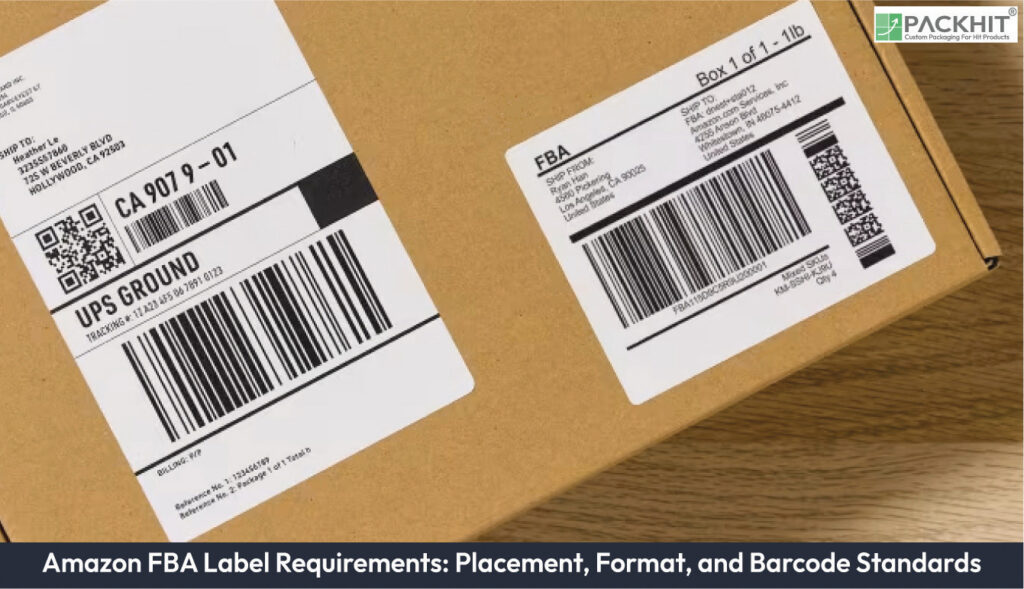Amazon FBA label requirements are integral to ensuring efficient inventory management and accurate product handling within Amazon’s fulfillment centers. These guidelines encompass three primary aspects: placement, format, and barcode standards. Labels must be affixed to flat, unobstructed surfaces of the product packaging, avoiding edges or curved areas to maintain scannability and compliance. Amazon enforces strict formatting rules, including minimum label dimensions of 2″ x 3″, clear inclusion of the FNSKU, product title, and barcode, and a minimum font size of 10 points. Thermal printing is recommended to produce durable, smudge-resistant labels. Barcode standards specify the use of Code 128 symbology, a minimum resolution of 300 DPI, and quiet zones of at least 0.25 inches around the barcode to ensure scanning accuracy. Non-compliance with these requirements may result in financial penalties, product rejections, or operational delays, emphasizing the critical importance of adhering to Amazon’s logistical protocols for manufacturers.
- What are Amazon FBA Label Placement Guidelines?
- What are the Formatting Requirements for Amazon FBA Labels?
- What Are Amazon’s Barcode Standards for FBA Labels?
- Preferred Barcode Type
- Minimum Printing Resolution
- Horizontal Placement and Alignment
- Quiet Zone Requirements
- Scannability Testing
- What Are the Consequences of Non-Compliance with Amazon FBA Label Requirements?
What are Amazon FBA Label Placement Guidelines?
Amazon mandates specific placement zones for Fulfillment by Amazon (FBA) labels to ensure unobstructed barcode scanning and accurate product identification during warehouse operations. Labels must be affixed to flat, unobstructed surfaces of the product packaging, avoiding edges, corners, or curved areas that may compromise scannability. For boxed items, the label should be placed on the largest flat surface, while polybagged items require the label to be positioned on the exterior, ensuring visibility through the bag. Labels must not overlap existing barcodes, branding, or other critical packaging elements to prevent scanning errors.
What are the Label Placement Restrictions for Different Packaging Types?
Amazon specifies distinct label placement rules based on packaging type:
- Boxed Items: Labels must be centered on the largest flat surface, avoiding seams or edges.
- Polybagged Items: Labels must be externally visible and positioned flat against the bag surface.
- Irregularly Shaped Items: Labels should be affixed to the most stable and flat area to ensure scannability.
- Bundled Products: Labels must indicate the bundle and be placed on the exterior packaging.
What are the Formatting Requirements for Amazon FBA Labels?
Amazon FBA labels must conform to specific formatting standards to ensure compatibility with warehouse scanning systems. These standards include label dimensions, font size, and content layout. Labels are required to measure 2″ x 3″ or larger, with a minimum font size of 10 points for text elements. The label must include the product title, FNSKU (Fulfillment Network Stock Keeping Unit), and scannable barcode, arranged in a clear and legible format. Amazon recommends using thermal printers for label generation to ensure durability and resistance to smudging during handling.
Label Content Specifications
Each FBA label must include the following elements:
- FNSKU: A unique identifier assigned by Amazon to track inventory.
- Product Title: The name of the product as listed on Amazon.
- Barcode: A scannable code, typically in Code 128 symbology, for inventory tracking.
- Prep Instructions: If applicable, instructions for handling or preparing the product.
Thermal Printing Standards
Amazon strongly recommends using thermal printers for label generation due to their ability to produce high-quality, smudge-resistant labels. Labels printed using inkjet or laser printers may degrade during transit or handling, leading to scanning errors. Thermal printers ensure consistent print quality, meeting Amazon’s durability standards for warehouse operations.
What Are Amazon’s Barcode Standards for FBA Labels?
Barcodes on Amazon FBA labels must meet stringent requirements to ensure compatibility with the company’s automated systems. These standards cover barcode symbology, scannability, printing resolution, and positioning.
Preferred Barcode Type
Amazon specifies Code 128 as the preferred barcode symbology for FBA labels due to its high data density and error correction capabilities. This format can efficiently encode alphanumeric data, making it ideal for inventory management. Manufacturers are encouraged to use this symbology to avoid compliance issues.
Minimum Printing Resolution
Barcodes must be printed at a minimum resolution of 300 DPI (dots per inch) to ensure clarity and scannability. High-resolution printing prevents distortion or degradation, which can result in scanning errors during warehouse operations.
Horizontal Placement and Alignment
The barcode must be positioned horizontally on the label for optimal scannability. This orientation aligns with Amazon’s scanning equipment and minimizes the risk of errors during automated processing. Proper alignment ensures smooth inventory tracking and product handling.
Quiet Zone Requirements
Amazon mandates the inclusion of quiet zones—blank spaces surrounding the barcode to facilitate accurate scanning. These quiet zones must measure at least 0.25 inches on all sides of the barcode. Insufficient spacing can lead to scanning failures and inventory discrepancies.
Scannability Testing
Manufacturers should conduct scannability tests under various lighting conditions and angles before shipping products to Amazon’s fulfillment centers. Testing ensures the barcodes meet Amazon’s standards for reliability and performance, reducing the likelihood of shipment rejections or delays.
What Are the Consequences of Non-Compliance with Amazon FBA Label Requirements?
Failure to adhere to Amazon FBA label requirements can result in significant operational disruptions, including product rejection, delayed shipments, and financial penalties. Non-compliant labels may lead to scanning errors, causing inventory discrepancies and delays in order fulfillment. Amazon may charge additional fees for re-labeling or reject shipments entirely, requiring manufacturers to rectify issues at their own expense.
Financial Penalties
Amazon imposes financial penalties for non-compliance, including re-labeling fees and storage charges for rejected shipments. These penalties can significantly impact a manufacturer’s profit margins, emphasizing the importance of strict adherence to label requirements.
Operational Delays
Non-compliant labels can cause delays in product processing and order fulfillment, leading to customer dissatisfaction and potential loss of sales. Manufacturers must ensure label accuracy and compliance to avoid disruptions in Amazon’s fulfillment workflow.

